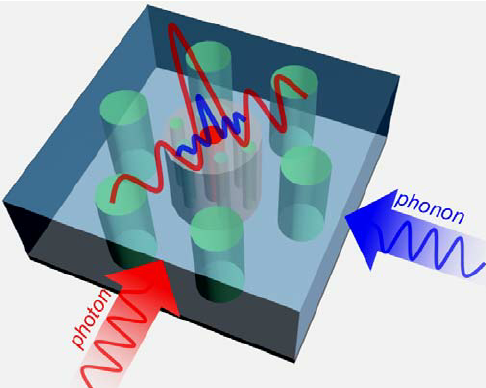Phoxonic Crystals: Manipulating Light and Sound at the Nanoscale
What are Phoxonic Crystals?
Phoxonic crystals are innovative materials that exhibit periodic structures capable of controlling and manipulating both photons (light) and phonons (sound) simultaneously at the nanoscale. These unique materials combine the properties of photonic crystals, which affect the motion of photons, and phononic crystals, which influence the propagation of phonons, to create a powerful platform for various applications in optics, acoustics, and optomechanics.

Key Concepts in Phoxonic Crystals
Phoxonic crystals are based on several fundamental concepts that enable their unique properties:
Photonic Band Gaps
Photonic crystals, a key component of phoxonic crystals, are materials with a periodic variation in their refractive index. This periodicity gives rise to photonic band gaps, which are frequency ranges where light propagation is prohibited. By carefully designing the structure and materials of the photonic crystal, researchers can control the flow of light and create optical waveguides, filters, and cavities.
Phononic Band Gaps
Similarly, phononic crystals exhibit periodic variations in their elastic properties, leading to phononic band gaps. These band gaps prevent the propagation of sound waves within specific frequency ranges. By engineering the phononic crystal structure, scientists can manipulate the flow of sound, create acoustic filters, and isolate mechanical vibrations.
Optomechanical Coupling
Phoxonic crystals harness the interaction between light and sound waves through optomechanical coupling. This coupling arises from the fact that light can exert pressure on mechanical structures, while mechanical vibrations can modulate the optical properties of materials. By carefully designing phoxonic crystals, researchers can enhance this optomechanical interaction and create novel devices for sensing, signal processing, and quantum technologies.
Phoxonic Metamaterials
Metamaterials are artificial structures engineered to exhibit properties not found in naturally occurring materials. In the context of phoxonic crystals, phoxonic metamaterials are designed to manipulate both light and sound waves in ways that surpass the limitations of conventional materials.
Negative Refraction
One of the most striking properties of phoxonic metamaterials is their ability to exhibit negative refraction for both light and sound waves. By carefully designing the subwavelength structure of the metamaterial, researchers can create materials with simultaneously negative permittivity and permeability for light, and negative density and bulk modulus for sound. This leads to the fascinating phenomenon of negative refraction, where light and sound waves bend in the opposite direction compared to conventional materials.
Cloaking and Invisibility
Phoxonic metamaterials can be engineered to guide light and sound waves around an object, effectively rendering it invisible to both optical and acoustic detection. This is achieved by creating a gradient of refractive indices that smoothly bends the waves around the object, without scattering or reflection. Phoxonic metamaterials offer the potential for advanced cloaking devices that can conceal objects from both sight and sound.
Enhanced Optomechanical Interactions
Metamaterials can be designed to enhance the optomechanical interactions in phoxonic crystals. By engineering subwavelength structures with high optical and mechanical quality factors, researchers can create metamaterials that exhibit strong optomechanical coupling, enabling efficient energy transfer between light and sound. This enhanced interaction can be harnessed for ultra-sensitive sensing, quantum optomechanics, and novel signal processing applications.
Fabrication of Phoxonic Crystals
The fabrication of phoxonic crystals requires precise control over the nanoscale structure and composition of the materials. Several techniques are employed to create these intricate structures:
Lithography
Lithographic techniques, such as electron beam lithography and nanoimprint lithography, are commonly used to pattern phoxonic crystal structures. These methods allow for the creation of periodic arrays of holes, pillars, or other geometries with nanoscale precision.
Self-Assembly
Self-assembly techniques, such as colloidal self-assembly and block copolymer lithography, offer a bottom-up approach to fabricating phoxonic crystals. These methods rely on the spontaneous organization of nanoscale building blocks into periodic structures, enabling the creation of large-area phoxonic crystals with reduced fabrication complexity.
3D Printing
Recent advancements in 3D printing technologies, such as two-photon polymerization and direct laser writing, have opened up new possibilities for fabricating complex phoxonic crystal structures. These techniques allow for the creation of three-dimensional phoxonic crystals with intricate geometries and functionalities.
Applications of Phoxonic Crystals
Phoxonic crystals have a wide range of potential applications across various fields:
Optomechanical Sensors
Phoxonic crystals can be used to develop highly sensitive optomechanical sensors for detecting small forces, displacements, and masses. By exploiting the strong optomechanical coupling in phoxonic crystals, researchers can create sensors with unprecedented sensitivity and resolution, enabling applications in biological sensing, environmental monitoring, and quantum metrology.
Acoustic Cloaking
The ability of phoxonic crystals to manipulate sound waves can be harnessed for acoustic cloaking applications. By carefully designing the phononic crystal structure, it is possible to guide sound waves around an object, making it effectively invisible to acoustic detection. This has potential applications in stealth technologies, noise reduction, and architectural acoustics.
Optomechanical Information Processing
Phoxonic crystals can serve as a platform for optomechanical information processing, where information is encoded in the mechanical vibrations of the crystal and processed using optical signals. This approach offers the potential for low-power, high-speed, and scalable information processing, with applications in signal processing, computing, and quantum technologies.
Challenges and Future Perspectives
While phoxonic crystals hold great promise, there are still challenges to be addressed for their widespread application. One of the main challenges is the fabrication of large-scale, defect-free phoxonic crystal structures with precise control over their optical and mechanical properties. Advances in nanofabrication techniques and materials science are crucial for overcoming these limitations.
Future research in phoxonic crystals will focus on exploring new material combinations, geometries, and functionalities to enhance their performance and broaden their application scope. The integration of phoxonic crystals with other nanoscale technologies, such as plasmonics, 2D materials, and quantum emitters, will open up new avenues for multifunctional devices and systems. Additionally, the development of active and tunable phoxonic crystals, where the optical and mechanical properties can be dynamically controlled, will enable novel applications in sensing, communication, and quantum technologies.
Further Reading
Comptes Rendus. Physique, Phoxonic crystals and cavity optomechanics
